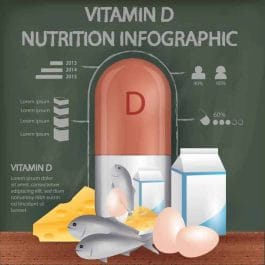
Vitamin D – properties and dosage. What are the symptoms of vitamin D deficiency and excess?
Vitamin D is one of those that has been in the news a lot in recent years. Mainly due to Due to the fact that it is estimated that almost 90% of the population suffer from a deficiency. Why? Vitamin D is called vitamin of the sun not without reason. It is, among other things sun rays provide it to our body. Vitamin D is responsible for the fact that we have so much energy in summer, but these are not its only properties. Its appropriate level influences good condition of the skeletal and cardiovascular system. However, we must be careful not to have too little or too much of it, because it is one of the components whose overdose is associated with ailments. What properties does vitamin D have, what its deficiency and excess and should it be supplementation?
Contents
Vitamin D – characteristics
Vitamin D is a group of organic compounds soluble in fats. organic compounds soluble in fats. The greatest importance for our The most important for our body are two forms of vitamin D: D2 (naturally naturally occurring in plants and D3 (naturally occurring in animals). naturally occurring in animal organisms).
Functions of vitamin D in the organism human body

Vitamin D has many useful functions in the human body Human body many useful functions. Among others:
- is responsible for maintaining normal bone health and structure;
- controls absorption of calcium from intestines and supports its metabolism;
- stimulates mineralization of bones and teeth;
- takes part in calcium and phosphorus metabolism;
- has a positive effect on muscles;
- takes part in blood pressure regulation;
- improves efficiency and performance of the body, which is why it is recommended for strength athletes and those who prefer intensivecardio training;
- supports insulin secretion;
- It supports the condition of hair and skin (vitamin D is often combined with Vitamin C or collagen in care cosmetics, reduces hair loss);
- D2 receptors prevent multiplication of cancer cells;
- prolongs the life of people with colon cancer;
- reduces the risk of autoimmune diseases, including type I diabetes, psoriasis, lupus;
- accelerates body recovery in case of overtraining or dehydration.
What is vitamin D deficiency and excess?
Vitamin D deficiency is caused by too poor diet, although vitamin D3 deficiency often appears also in autumn, when the sun is rarely visible in the sky. Just 20 minutes of daily exposure to sunlight allows the body to produce the amount of vitamin D3 it needs.
It is also important to know that Vitamin D can be overdosed. This usually happens when in addition to excessive exposure to the sun, we also use special supplementation, containing too much vitamin D3. D3. However, in order for unpleasant symptoms to appear, the vitamin must be overdosed in quite a large number.
Symptoms and effects of vitamin D deficiency
Symptoms of vitamin D deficiency are:
- gum and periodontal disease;
- bone and muscle pain, e.g. severe back pain;
- sleep disorders;
- loss of appetite;
- diarrhoea;
- visual disturbances;
- a burning sensation in the mouth.
Effects of vitamin D deficiency
Too little vitamin D may contribute to the development of rickets in children and osteoporosis in adults. adults. Other effects include:
- muscle weakness (painful cramps occur, sometimes also problems with walking);
- increased risk of developing overweight and obesity;
- increased susceptibility to cardiovascular diseases, as well as other diseases such as: diabetes, rheumatoid arthritis, lupus, multiple sclerosis);
- acceleration of the ageing process.
Read also: Fight free radicals with coenzyme Q10
Vitamin D deficiency during pregnancy
Vitamin D deficiency in the future mother may lead to impaired development of brain functions in the child and permanent damage to the brain, which increases the This increases the risk of schizophrenia or autism.
Vitamin D deficiency in infants
It manifests itself by an excessively flat head back, and convex forehead bumps may appear on the forehead. There is a delay in the fusion of the fontanel. It can frog belly (when the baby lies down, the belly spills over to the sides). to the sides). This is a result of rickets ribs and weak abdominal muscles. abdominal muscles.
Symptoms and effects of excess vitamin D
It happens rarely, but vitamin D can also be overdosed. Symptoms of its excess are:
- loss of appetite;
- increased thirst;
- nausea;
- increased urination;
- general weakness;
- increased sweating;
- diarrhea;
- vomiting;
- itching of the skin;
- pain and itching of the eyes.
Anoverdose of vitamin D can have unpleasant consequences for our body. The negative effects of excess vitamin D include:
- accumulation of calcium in tissues, which can lead to problems with heart and the functioning of the nervous system;
- an increased risk of gallstones gallbladder and kidney stones.
Overdose of vitamin D during pregnancy can lead to deformities and bone disease in the newborn.
Sources of vitamin D
In addition to sunlight, vitamin D D can also be obtained from food. It can be found, among others We can find it in sea fish (eel, mackerel, herring, cod), cow’s milk, eggs, cheese.
Vitamin D dosage – division age
It is worth remembering that vitamin D is supplied to our body with sunlight and food. In order to know whether we suffer from its deficiency, we should perform special blood tests. It is also worth knowing the appropriate doses daily doses of vitamin D for a specific age group.
Children – 1-10 years
Appropriate daily dose of vitamin D depends on body weight and ranges from 600 to 1000 IU. consult a doctor, who will determine the specific dose for the child child. Deficiencies in children most often occur in the autumn and winter It is best to consult a doctor, who will determine a specific dose for your child.
Adolescents 11-18 years
Vitamin D deficiency in adolescents Deficiency in adolescents is relatively rare, because at this age children often spend outdoors, and just 15 minutes of exposure to sunlight is enough to 15 minutes of sun exposure is enough to provide them with the required dose. In autumn and winter In autumn and winter it is possible to support the organism of a young person with a supplementation of from 800 to 2000 IU depending on body weight and the amount of vitamin D the amount of vitamin D consumed in food.
Vitamin D dosage in adults (healthy people, without contraindications)
The dosage in adults also depends on body weight and is similar as in the case of adolescents, that is, it is from 800 to 2000 IU. Chronically ill persons or persons people who are chronically ill or who suffer from other diseases, especially those associated with malabsorption, should determine the individual dose of vitamin D should establish with a doctor.
Vitamin D – facts and myths

On the subject of vitamin D we can hear many information, but not all of them are true. Below Here is what else you should know about vitamin D.
Vitamin D supplementation works only if you provide vitamins D2 and D3
In pharmacies, you will most often find dietary supplements with vitamin D3, rarely with added vitamin D2. Does this make any difference? It is estimated that the overall effect of both vitamins on human organism is the same, however, the newest studies show that vitamin D3, or cholecalciferol has more effective in assimilating, and thus increasing concentration of vitamin D in the blood. Vitamins D2 and D3 should not be administered interchangeably.
The use of sunscreens with cream prevents our body from absorbing vitamin D from the sun
A large part of the requirement for Vitamin D3 is supplemented by vitamin D synthesis from the sun. In spring and summer, just 15 minutes of exposure to sunlight can deliver an adequate dose of vitamin D3 to our body. body.
However, there is a lot of talk about the fact that skin should be protected from the sun and it is recommended to use of sunscreens. But do not filters make that our skin will not absorb vitamin D3 from the sun? Studies show that the use of sunscreen reduces the synthesis of of vitamin D, but only slightly. With prolonged exposure, our bodies body will absorb as much as it needs. During the periods autumn and winter, in cloudy, rainy weather, it is often it is recommended to supplement vitamin D deficiency with special supplementation.
When using vitamin D supplementation 3 the highest doses should be consumed
The required concentration of vitamin D in blood varies with age and gender. Special tests will help us to determine them should be carried out especially by people :
- with osteoporosis and rickets;
- with malabsorption;
- Those on an elimination diet;
- suffering from hyperparathyroidism;
- suffering from autoimmune diseases;
- with obesity and fighting with overweight.
Adults should take vitamin D3 take in accordance with a standard appropriate to their needs. You can consult this standard with your doctor or follow the the ranges shown above. Most supplements are created in the appropriate dose for children and adults.
Vitamin D and cancer prevention

Research is still being conducted on the action of vitamin D in cancer prevention. Already in 1941 the effect of irradiation on inhibition of tumor cells tumor cells. The results of the research report that vitamin D may have in the prevention of colorectal cancer, breast cancer, mammary cancer, ovarian, and even pancreatic cancer.
Although the results of the study are still insufficient to constitute a firm hypothesis, tests are still ongoing. Regardless of whether the suspected salutary effect of of vitamin D’s cancer-suppressing effects will be confirmed, it is vitamin that performs many important functions in the human body in the human body. Unfortunately, its deficiencies occur frequently, especially elderly people and in the autumn and winter period, in cloudy weather. It is the sunlight that allows the best synthesis of Vitamin D3 can also be supplied from food. Regardless of age and sex, every person must watch out for its deficiency, because it is connected with serious consequences.
Vitamin D3 + K2 – why is this combination so common?
Vitamin D3 helps our body to deposit calcium, but it is vitamin K2 that makes it get delivered to where our body needs it most. Taking vitamin K2 with vitamin D3 supplementation reduces the risk of calcium build-up in the arteries.
It is also important to remember that vitamin D is one of those that can be overdosed. So if we decide on supplementation, we should choose capsules in a dose dosage which will allow us to provide its optimal amount, adapted to our body weight and age.



